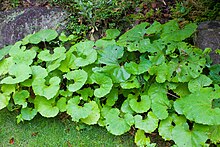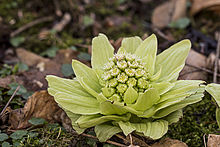| Giant butterbur | |
|---|---|

| |
| Adult fuki | |

| |
| Fuki shoot | |
| Scientific classification | |
| Kingdom: | Plantae |
| Clade: | Tracheophytes |
| Clade: | Angiosperms |
| Clade: | Eudicots |
| Clade: | Asterids |
| Order: | Asterales |
| Family: | Asteraceae |
| Genus: | Petasites |
| Species: | P. japonicus
|
| Binomial name | |
| Petasites japonicus | |
| Nutritional value per 100 g (3.5 oz) | |||||||||||||||||||||||||||||||||||||||||||
|---|---|---|---|---|---|---|---|---|---|---|---|---|---|---|---|---|---|---|---|---|---|---|---|---|---|---|---|---|---|---|---|---|---|---|---|---|---|---|---|---|---|---|---|
| Energy | 59 kJ (14 kcal) | ||||||||||||||||||||||||||||||||||||||||||
3.61 g | |||||||||||||||||||||||||||||||||||||||||||
0.04 g | |||||||||||||||||||||||||||||||||||||||||||
0.39 g | |||||||||||||||||||||||||||||||||||||||||||
| |||||||||||||||||||||||||||||||||||||||||||
| †Percentages estimated using US recommendations for adults,[1] except for potassium, which is estimated based on expert recommendation from the National Academies.[2] | |||||||||||||||||||||||||||||||||||||||||||

Petasites japonicus, also known as butterbur, giant butterbur, great butterbur and sweet-coltsfoot, is an herbaceous perennial plant in the family Asteraceae.[3] It is native to China, Japan, Korea and Sakhalin and introduced in Europe and North America. It was introduced to southern British Columbia in Canada by Japanese migrants.[4][5]
It is dioecious, with male and female flowers produced on separate individuals. Occasionally, morphologically hermaphroditic (but functionally sterile) flowers exist.[6]
- ^ United States Food and Drug Administration (2024). "Daily Value on the Nutrition and Supplement Facts Labels". FDA. Archived from the original on 2024-03-27. Retrieved 2024-03-28.
- ^ National Academies of Sciences, Engineering, and Medicine; Health and Medicine Division; Food and Nutrition Board; Committee to Review the Dietary Reference Intakes for Sodium and Potassium (2019). Oria, Maria; Harrison, Meghan; Stallings, Virginia A. (eds.). Dietary Reference Intakes for Sodium and Potassium. The National Academies Collection: Reports funded by National Institutes of Health. Washington, DC: National Academies Press (US). ISBN 978-0-309-48834-1. PMID 30844154. Archived from the original on 2024-05-09. Retrieved 2024-06-21.
- ^ "Petasites japonicus". Germplasm Resources Information Network. Agricultural Research Service, United States Department of Agriculture.
- ^ Pojar, Jim; MacKinnon, Andy (1994). Plants of the Pacific Northwest Coast. Lone Pine Publishing. p. 294. ISBN 978-1-55105-040-9.
- ^ Fawcett-Atkinson, Marc (18 June 2021). "Why a Japanese Delicacy Grows Near Old British Columbia Internment Camps". Atlas Obscura. Retrieved 30 June 2021.
- ^ Sakai, Satoki; Suzuki, Yuka; Itagaki, Tomoyuki; Tsujisawa, Hisashi; Makino, Takashi T. (2008). "On the function of hermaphrodite florets in female inflorescences of Petasites japonicus (Asteraceae)". Botany. 86 (2): 179–184. doi:10.1139/B07-121.